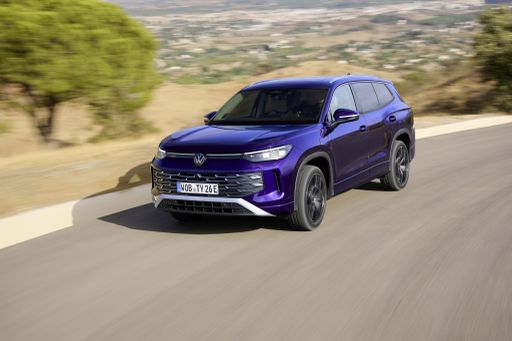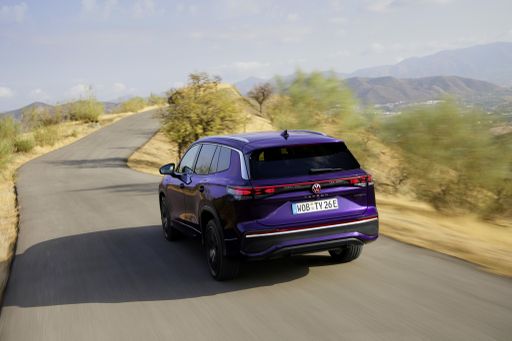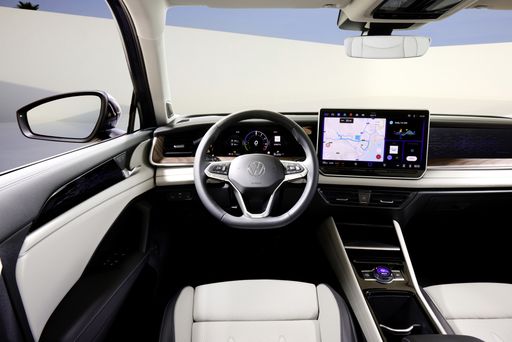VW Tayron vs MG HS/EHS – Differences & prices compared
Compare performance, boot space, consumption and price in one view.
Find out now: which car is the better choice for you – VW Tayron or MG HS/EHS?
The VW Tayron (SUV) comes with a Petrol MHEV, Plugin Hybrid, Diesel or Petrol engine and Automatic transmission. In comparison, the MG HS/EHS (SUV) features a Petrol or Plugin Hybrid engine with Manuel or Automatic transmission.
When it comes to boot capacity, the VW Tayron offers 885 L, while the MG HS/EHS provides 507 L – depending on how much space you need. If you’re looking for more power, decide whether the 272 HP of the VW Tayron or the 272 HP of the MG HS/EHS suits your needs better.
In terms of consumption, the values are 0.40 L per 100 km for the VW Tayron, and 0.50 L for the MG HS/EHS.
Price-wise, the VW Tayron starts at 39000 £, while the MG HS/EHS is available from 24000 £. Compare all the details and find out which model fits your lifestyle best!
VW Tayron
The Tayron stands out as a stylish and versatile SUV that expertly blends form and function. With its spacious interior and modern design, it caters to families and adventure seekers alike, making every journey enjoyable. Equipped with advanced technology and safety features, the Tayron promises a driving experience that is both secure and exhilarating.
details @ volkswagen-newsroom.com
@ volkswagen-newsroom.com
 @ volkswagen-newsroom.com
@ volkswagen-newsroom.com
 @ volkswagen-newsroom.com
@ volkswagen-newsroom.com
 @ volkswagen-newsroom.com
@ volkswagen-newsroom.com
MG HS/EHS
The MG HS, also known as the EHS in its hybrid variant, is a midsize SUV that combines modern design with a focus on comfort and technology. Its spacious interior offers a premium feel, enhanced by quality materials and an array of advanced features aimed at ensuring a smooth driving experience. Known for its efficiency, the MG HS/EHS delivers an enjoyable ride whether navigating city streets or taking on longer road trips.
details

|
|
|
|
|
Costs and Consumption |
|
|---|---|
|
Price
39000 - 52600 £
|
Price
24000 - 36000 £
|
|
Consumption L/100km
0.4 - 7.8 L
|
Consumption L/100km
0.5 - 7.6 L
|
|
Consumption kWh/100km
-
|
Consumption kWh/100km
-
|
|
Electric Range
117 - 126 km
|
Electric Range
100 km
|
|
Battery Capacity
19.70 kWh
|
Battery Capacity
-
|
|
co2
9 - 177 g/km
|
co2
14 - 173 g/km
|
|
Fuel tank capacity
45 - 58 L
|
Fuel tank capacity
55 L
|
Dimensions and Body |
|
|---|---|
|
Body Type
SUV
|
Body Type
SUV
|
|
Seats
5
|
Seats
5
|
|
Doors
5
|
Doors
5
|
|
Curb weight
1682 - 1948 kg
|
Curb weight
1625 - 1930 kg
|
|
Trunk capacity
705 - 885 L
|
Trunk capacity
441 - 507 L
|
|
Length
4792 mm
|
Length
4655 - 4670 mm
|
|
Width
1853 - 1866 mm
|
Width
1890 mm
|
|
Height
1666 - 1668 mm
|
Height
1663 - 1664 mm
|
|
Payload
489 - 566 kg
|
Payload
400 kg
|
Engine and Performance |
|
|---|---|
|
Engine Type
Petrol MHEV, Plugin Hybrid, Diesel, Petrol
|
Engine Type
Petrol, Plugin Hybrid
|
|
Transmission
Automatic
|
Transmission
Manuel, Automatic
|
|
Transmission Detail
Dual-Clutch Automatic
|
Transmission Detail
Manual Gearbox, Dual-Clutch Automatic, Automatic Gearbox
|
|
Drive Type
Front-Wheel Drive, All-Wheel Drive
|
Drive Type
Front-Wheel Drive
|
|
Power HP
150 - 272 HP
|
Power HP
170 - 272 HP
|
|
Acceleration 0-100km/h
6.1 - 9.7 s
|
Acceleration 0-100km/h
6.8 - 9.6 s
|
|
Max Speed
204 - 240 km/h
|
Max Speed
190 - 195 km/h
|
|
Torque
250 - 400 Nm
|
Torque
275 - 350 Nm
|
|
Number of Cylinders
4
|
Number of Cylinders
4
|
|
Power kW
110 - 200 kW
|
Power kW
125 - 200 kW
|
|
Engine capacity
1498 - 1984 cm3
|
Engine capacity
1496 cm3
|
General |
|
|---|---|
|
Model Year
2025
|
Model Year
2024
|
|
CO2 Efficiency Class
E, B, F, G
|
CO2 Efficiency Class
F, B
|
|
Brand
VW
|
Brand
MG
|
VW Tayron
Introducing the VW Tayron: Where Innovation Meets Performance
The VW Tayron is making waves in the SUV market with its cutting-edge technology, impressive performance specifications, and versatile engine options, catering to a diverse range of drivers. As a compact SUV, the Tayron perfectly balances functionality and style, making it an attractive choice for both urban and adventurous lifestyles. Let's dive into the technical aspects and innovations that set the Tayron apart.
Engine Options and Performance
The Tayron is available in several configurations, each engineered to deliver a thrilling driving experience. Among the most notable is the 1.5 eTSI OPF Petrol MHEV engine, boasting an output of 150 horsepower. This variant showcases a superb balance between power and efficiency, achieving an impressive fuel consumption of just 6.2 liters per 100 kilometers.
Additionally, the Tayron offers hybrid options, such as the 1.5 eHybrid OPF Plugin Hybrid. This model can produce up to 204 horsepower, with an electric range of 126 kilometers, allowing drivers to experience the benefits of electric motoring without sacrificing performance. For those who prefer diesel, the 2.0 TDI SCR Diesel engine delivers a robust 193 horsepower, paired with either front-wheel or all-wheel drive configurations. This versatility ensures that there's a suitable option for every type of driver.
Cutting-Edge Technology and Features
The Tayron is equipped with an array of advanced technologies designed to enhance comfort, safety, and connectivity. Its automatic transmission features a dual-clutch system, providing smooth gear shifts and optimal power delivery. The vehicle's driving dynamics are further improved by the availability of Dynamic Chassis Control, allowing drivers to select their preferred driving mode for any given scenario.
Inside, the Tayron boasts a spacious cabin with ample seating for five, complemented by modern design elements and high-quality materials. The trunk capacity reaches up to 885 liters, making it ideal for family outings or long road trips. Furthermore, the integration of the latest infotainment system ensures that drivers remain connected on the go, offering seamless smartphone compatibility through Apple CarPlay and Android Auto.
Safety Comes First
Safety is paramount in the Tayron's design. Equipped with state-of-the-art driver assistance systems, the SUV helps prevent accidents and enhances overall road safety. Features such as adaptive cruise control, blind-spot monitoring, and lane-keeping assist are just some of the innovative safety elements offered in the Tayron. With its comprehensive safety suite, the Tayron provides peace of mind for both drivers and passengers alike.
A Sustainable Future with the Tayron
As environmental awareness continues to grow, the VW Tayron contributes to a more sustainable future through its hybrid variants that feature lower emissions. For instance, the 1.5 eHybrid OPF Plugin Hybrid achieves a CO2 efficiency class of B, demonstrating VW’s commitment to eco-friendly mobility without compromising performance. This shift toward sustainability is becoming increasingly significant for consumers looking for responsible yet fun driving experiences.
Conclusion: The VW Tayron Stands Out
The VW Tayron is a remarkable SUV that encapsulates the perfect blend of performance, technology, and sustainability. With its diverse range of engine options, advanced features, and focus on safety, it is tailored to meet the needs of modern drivers. Whether you opt for the petrol, diesel, or hybrid model, the Tayron is sure to impress with its dynamic capabilities and stylish design, solidifying its place in the competitive automotive landscape.
MG HS/EHS
Unveiling the MG HS/EHS: A Fusion of Elegance and Power
The MG HS/EHS has made a resounding impact in the SUV landscape, embodying a perfect blend of style, innovation, and performance. As the automotive world shifts towards sustainable yet powerful solutions, the MG HS/EHS stands tall, offering options that cater to both traditional petrol enthusiasts and the eco-conscious consumer. This SUV not only exemplifies versatility but also elevates the driving experience to new heights.
Cutting-Edge Engine Configurations
The MG HS/EHS comes in several configurations, ensuring that every driver can find a model that suits their lifestyle. The petrol versions are powered by a 1.5T GDI engine, delivering a robust 170 HP and options for both manual and automatic transmissions. For those looking to embrace hybrid technology, the Plug-in Hybrid Electric Vehicle (PHEV) variant offers a remarkable 272 HP with an impressive electric range of 100 km, making it an ideal choice for urban and long-distance journeys alike.
Performance and Fuel Efficiency
With a petrol consumption ranging between 7.4 L and 7.6 L per 100 km, and the hybrid variant consuming just 0.5 L per 100 km, the MG HS/EHS manages to balance power and efficiency deftly. The SUV accelerates from 0 to 100 km/h in as little as 6.8 seconds, depending on the model, and reaches top speeds of up to 195 km/h, making it competitive in its class.
Innovative Design and Comfort
The MG HS/EHS is not just about performance; it’s also about comfort and sophistication. With a length of 4670 mm and a width of 1890 mm, the SUV boasts a spacious interior that comfortably accommodates five passengers. The cabin is designed to maximize both driver and passenger comfort, featuring ergonomic seating and state-of-the-art infotainment systems to enhance the overall driving experience.
Technology and Safety Features
Safety and technology are at the forefront of the MG HS/EHS design. The model is equipped with advanced driver-assist systems and AI-driven safety features that provide additional peace of mind on the road. Additionally, the MG HS/EHS integrates cutting-edge infotainment technology, keeping drivers connected while ensuring a seamless driving experience.
Sustainability Meets Luxury
With CO2 emissions as low as 14 g/km for the hybrid model, the MG HS/EHS demonstrates MG's commitment to sustainability without compromising on luxury. The low emissions make it an attractive option for environmentally conscious drivers who refuse to sacrifice style and power.
In conclusion, the 2024 MG HS/EHS beautifully encapsulates the evolution of modern SUVs, where elegance meets power and innovation. Whether it's the high-powered petrol engine or the environmentally friendly hybrid model, the MG HS/EHS is poised to lead the charge towards the future of driving.
The prices and data displayed are estimates based on German list prices and may vary by country. This information is not legally binding.
